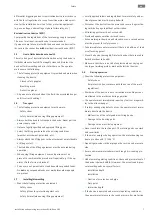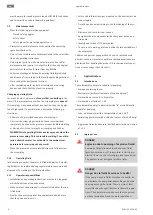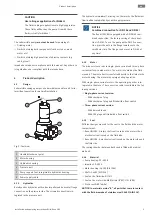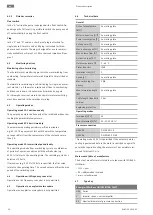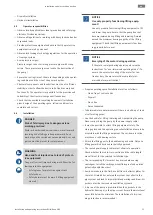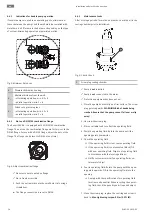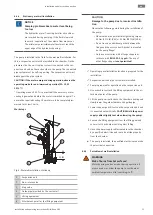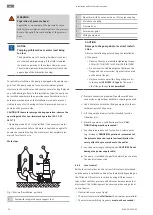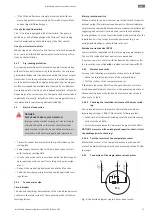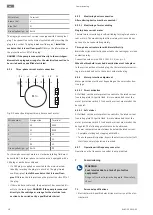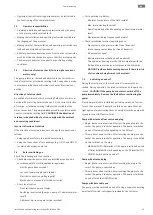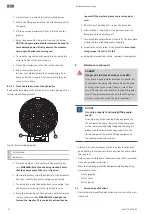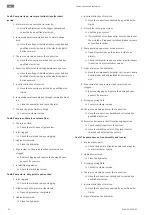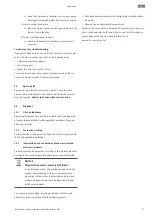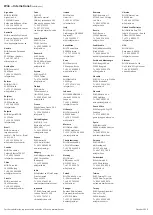
en
Shut-down/dismantling
20
WILO SE 2019-02
7.6
During operation
WARNING
Amputation of limbs due to rotating compon-
ents!
No persons must be present in the work area of the
pump! There is risk of (serious) injuries due to rotat-
ing components! No persons must be present in the
work area of the pump during start-up or operation.
WARNING
Risk of burns from hot surfaces!
Motor housing can become hot during operation. It
may cause burns. Allow the pump to cool down at
ambient temperature after switching it off!
NOTICE
Pumping problems due to water level being
too low
The hydraulics are self-venting. Smaller air cushions
are resorbed during pumping. If the fluid is lowered
too much, separation of the volume flow may occur.
The minimum permissible water level must reach the
upper edge of the hydraulics housing!
When operating the pump, observe the locally applicable regula-
tions on the following topics:
ƒ
Work safety
ƒ
Accident prevention
ƒ
Handling electrical machines
Strictly adhere to the responsibilities of the personnel specified
by the operator. All personnel are responsible for ensuring that
the responsibilities of the personnel and the regulations are ob-
served!
Due to their design, centrifugal pumps have rotating parts that
are easily accessible. Depending on the operating condition,
sharp edges can develop on these parts.
WARNING! This can lead
to cuts and limbs may be severed!
Check the following at regu-
lar intervals:
ƒ
Operating voltage (+/-10 % of the rated voltage)
ƒ
Frequency (+/-2 % of the rated frequency)
ƒ
Power consumption between individual phases (max. 5 %)
ƒ
Voltage difference between the individual phases (max. 1 %)
ƒ
Max. switching frequency
ƒ
Minimum water submersion depending on the operating mode
ƒ
Inlet: no air intake
ƒ
Level control device/dry-running protection: Switching points
ƒ
Quiet/low-vibration running
ƒ
All gate valves open
8
Shut-down/dismantling
8.1
Personnel qualifications
ƒ
Operation/control: Operating personnel must be instructed in
the functioning of the complete system.
ƒ
Electrical work: A qualified electrician must carry out the elec-
trical work.
ƒ
Installation/dismantling: The technician must be trained in the
use of the necessary tools and fixation materials for the relev-
ant construction site.
8.2
Operator responsibilities
ƒ
Locally applicable accident prevention and safety regulations
of trade associations.
ƒ
Observe regulations for working with heavy loads and under
suspended loads.
ƒ
Provide the necessary protective equipment and make sure
that the personnel wears it.
ƒ
Provide adequate aeration in closed rooms.
ƒ
Take immediate countermeasures if there is a build-up of
toxic or suffocating gases!
8.3
Shut-down
The pump is deactivated during decommissioning, but remains
installed. This ensures that the pump is always ready for opera-
tion.
‡
To protect the pump from frost and ice, always immerse
the pump completely in the fluid.
‡
The temperature of the fluid must always be above
+3 °C (+37 °F).
1. Switch off the pump at the operating point.
2. Secure the operating point against being switched on
again by unauthorised persons (e.g. lock main switch).
▶ The pump is out of operation and can now be dis-
mantled.
If the pump remains installed after decommissioning, observe the
following:
ƒ
Ensure that the prerequisites for decommissioning are main-
tained for the complete period of decommissioning. If these
prerequisites cannot be guaranteed, dismantle the pump after
decommissioning!
ƒ
For an extended period of decommissioning, carry out a 5-
minute function test at regular intervals (monthly to
quarterly).
CAUTION! A function test may only be carried out
under the applicable operating conditions. A dry run is not
permitted! Non-compliance can result in irreparable dam-
age!


